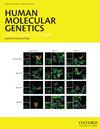TTN 单倍变体导致骨骼肌疾病的病理机制
IF 3.1
2区 生物学
Q3 BIOCHEMISTRY & MOLECULAR BIOLOGY
引用次数: 0
摘要
已知滴定蛋白基因(TTN)的致病变异可导致多种心脏和肌肉骨骼疾病,而骨骼肌病大多归因于双等位基因变异。我们在患有轻度、进行性轴向和近端乏力,且随着年龄的增长经常出现扩张型心肌病的原发性患者中发现了 TTN 的单等位截短变异(TTNtv)、剪接位点或内部缺失。在所研究的 8 个家族中,有 7 个家族的这些变异体是常染色体显性遗传。我们研究了这些变异对 mRNA、蛋白质水平以及骨骼肌结构和功能的影响。结果显示,无义介导的衰变可能会防止 TTNtvs 患者的有害截短蛋白在骨骼肌中积累。剪接变异和框架外缺失会诱发异常外显子跳转,而框架内缺失则会产生N端和C端完整的缩短的titin,导致肉瘤结构破坏。所有变异类型都与剪接模式的全基因组变化有关,而剪接模式是疾病进展的标志。最后,RNA-seq研究发现,TGF-β超家族成员GDF11在患病组织中上调,这表明它可能是骨骼肌钛蛋白病的有效治疗靶点。本文章由计算机程序翻译,如有差异,请以英文原文为准。
Pathomechanisms of Monoallelic variants in TTN causing skeletal muscle disease
Pathogenic variants in the titin gene (TTN) are known to cause a wide range of cardiac and musculoskeletal disorders, with skeletal myopathy mostly attributed to biallelic variants. We identified monoallelic truncating variants (TTNtv), splice site or internal deletions in TTN in probands with mild, progressive axial and proximal weakness, with dilated cardiomyopathy frequently developing with age. These variants segregated in an autosomal dominant pattern in 7 out of 8 studied families. We investigated the impact of these variants on mRNA, protein levels, and skeletal muscle structure and function. Results reveal that nonsense-mediated decay likely prevents accumulation of harmful truncated protein in skeletal muscle in patients with TTNtvs. Splice variants and an out-of-frame deletion induce aberrant exon skipping, while an in-frame deletion produces shortened titin with intact N- and C-termini, resulting in disrupted sarcomeric structure. All variant types were associated with genome-wide changes in splicing patterns, which represent a hallmark of disease progression. Lastly, RNA-seq studies revealed that GDF11, a member of the TGF-β superfamily, is upregulated in diseased tissue, indicating that it might be a useful therapeutic target in skeletal muscle titinopathies.
求助全文
通过发布文献求助,成功后即可免费获取论文全文。
去求助
来源期刊

Human molecular genetics
生物-生化与分子生物学
CiteScore
6.90
自引率
2.90%
发文量
294
审稿时长
2-4 weeks
期刊介绍:
Human Molecular Genetics concentrates on full-length research papers covering a wide range of topics in all aspects of human molecular genetics. These include:
the molecular basis of human genetic disease
developmental genetics
cancer genetics
neurogenetics
chromosome and genome structure and function
therapy of genetic disease
stem cells in human genetic disease and therapy, including the application of iPS cells
genome-wide association studies
mouse and other models of human diseases
functional genomics
computational genomics
In addition, the journal also publishes research on other model systems for the analysis of genes, especially when there is an obvious relevance to human genetics.
 求助内容:
求助内容: 应助结果提醒方式:
应助结果提醒方式:


